How Winter Guard Turned Into a Long-Term Picture Project
In September of 2002, I took a temporary position teaching photography at a Southern California high school. I hadn’t photographed seriously in many years. All during high school and college (20 years ago), I shot in the spirit of the old-school photojournalists. That means choosing a subject and photographing it over a long period of time, with the hopes of making a group of pictures that are both artistic and would educate the viewer about the subject. This is called a “photo essay.” A good photo essay shows several aspects of the subject, good and bad, but most importantly, is truthful.
Choosing the Subject
On my first day at school, I went around the room and asked each student the same questions: “Have you ever been to a museum? Do you have a favorite artist? Are you in any sports or clubs?” and “What do you think you want to photograph this year?”
The last two questions were meant to give them the idea that they might want to make a photo essay of whatever sport or club they’re in.
Elizabeth was in my first period class. She said she was in guard. I sort of knew what it was; my high school didn’t have one but somehow I had an idea. I made a mental note that this may be something with picture possibilities.
After a few weeks at the job, I thought it was a good time to find a subject for a photo essay, both as a creative outlet for myself and to show my students that there are subjects worth photographing almost everywhere. I coined the phrase “visually interesting,” which I used in class all the time, to describe the sort of subject they should be looking for. Let’s face it, the chess club wasn’t going to lend itself to exciting pictures whereas the dance team would.
I have to confess, I started with the cheerleaders. What’s not visually interesting about them? While that may be true, after two attempts to photograph them at football games, it was clear they didn’t want me around.
The Complete Guard Experience
I asked Elizabeth who the guard advisor was, when and where they practiced and did she think the advisor would mind if I came by one evening to take some pictures. She gave me all the information and said she didn’t think the advisor would mind. I showed up at the next practice, and Elizabeth was right.
I started shooting a lot, about four rolls a night (with 36 pictures on each roll). The guard girls not only didn’t mind me there, they pretty much ignored me, which is great for a photojournalist. (The last thing we want is a subject posing for pictures, giving the photographs a phony look.) Each time I’d return, I’d bring a handful of pictures to give out. Once I did that, I was welcome to photograph them wherever and whenever I wanted to.
I went into this project with a few preconceived ideas of the sort of pictures I was looking for. I knew that in guard, as any sport, there would be wins and defeats, friendships and rivalries, and a time for hard work and a time for celebrating. I wanted to see if I could capture these emotions in photographs, thereby showing the guard experience. But I was also ready for the unknown. I was hoping to get other pictures that are unique to guard, to show the complete guard experience.
Here are some of those photographs. I hope you enjoy looking at them as much as I enjoyed shooting them. Perhaps some of you will be inspired to photograph your guard over a long period of time and create your own photo essay. After all, what’s more visually interesting than guard?
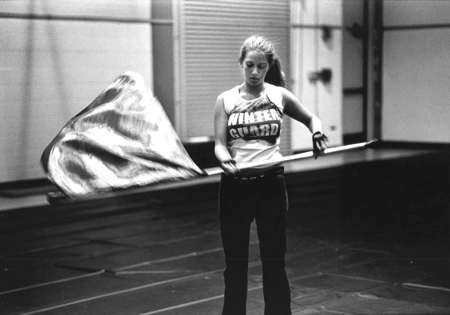 |
Elizabeth used her full name in class but went by Liz in guard. The reason is that if a wayward saber flies through the air in her direction, someone can shout “Liz!” (rather than the four-syllable “Elizabeth!”) and cut down on her reaction time. |
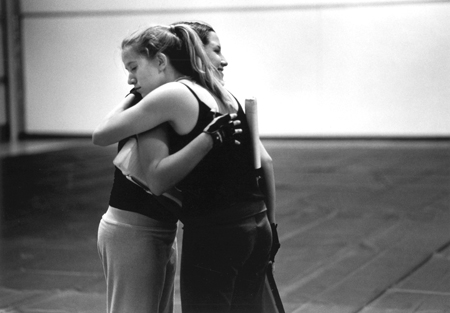 |
There’s a lot of love in guard. The girls are very close and are always ready to give a hug when one is needed. They socialize with each other outside of guard. Unfortunately, the other clubs and teams don’t socialize with guard at all. |
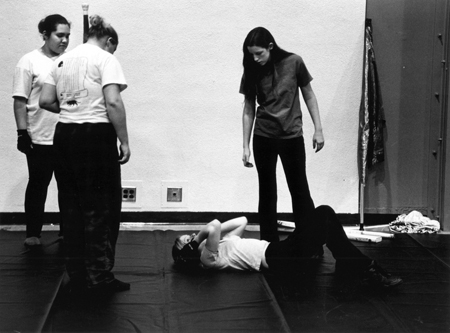 |
There’s a lot of drama, too. Sometimes personalities would clash, but everyone would make up fairly soon. As with any team, not everyone is going to be in harmony with everyone else all the time. Katie spent a lot of time on the floor. |
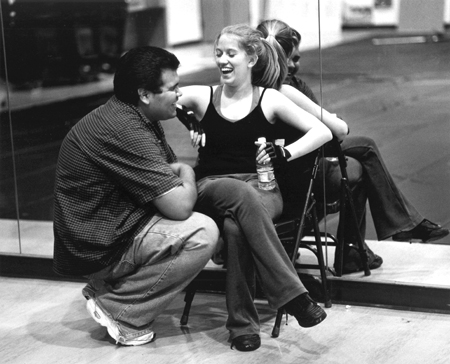 |
Most of the boys couldn’t see that guard was a great place to meet girls. |
 |
My second year at the school, a new guard advisor took over. He was tough. If one of the girls said a swear word, the penalty was a lap around the track.
It appeared, at first, that no one was having fun. Ruthie, the team captain, considered quitting. Some girls did. We didn’t know it at the time, but all this tough love was going to pay off by the end of the season. |
 |
Right before a competition is a strange time. Everyone is nervous, including me, but no one admits it. They quietly put on their wardrobe and makeup and await their turn to perform. |
 |
After performing one Saturday, the girls cheered for another guard they knew in the competition. To me this showed great sportsmanship, which I found to be typical of guard. |
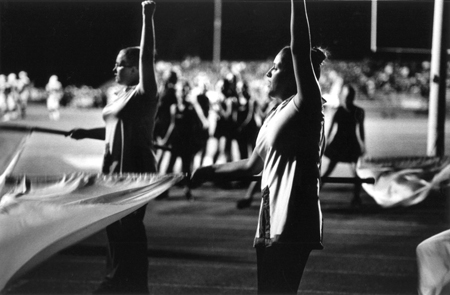 |
After a halftime performance, one of the guard girls said to another, “I heard people clapping who weren’t our parents.” |
 |
I asked Genna why she thinks the rest of the student body barely acknowledges guard exists.
She said, “Most people think of it as like a military thing, so a bunch of chicks doing military moves and stuff; it’s just weird to them. And they think it’s not like a popular sport in this school ‘cause you got the jocks and the cheerleaders and the dance team, so nobody really cares about us.” |
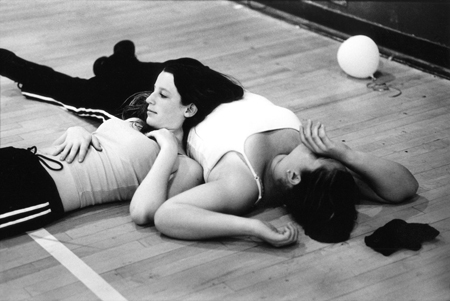 |
Why does everyone use Stefanie as a pillow? |
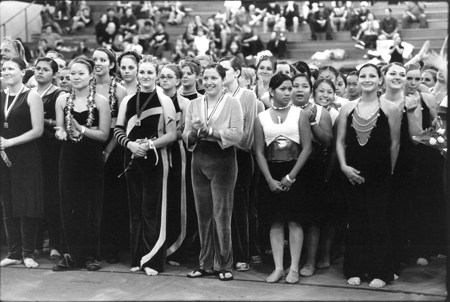 |
At the Winter Guard Association of Southern California championship in 2004, our team came in second place.
Ruthie (center of picture), the captain, was glowing at the awards ceremony. Liz was a senior and chose not to participate in guard that year, which didn’t sit well with the rest of the team. I couldn’t help but think she was missing out on their finest hour. |
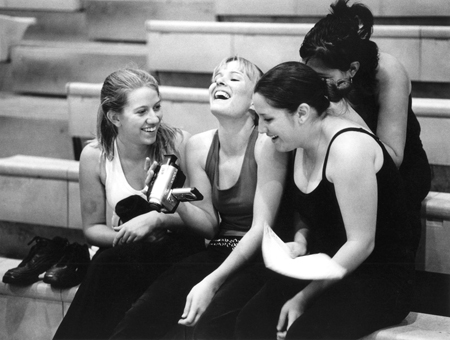 |
I always tried to encourage my students to join a team or a club. I felt having something to do other than homework would keep them out of trouble, plus there’s the satisfaction that comes with being part of a group with a common goal.
One girl in my class expressed her dissatisfaction with the cheerleaders, and color guard was having tryouts that very week. I encouraged her to go, but she said no. It was her loss. |

